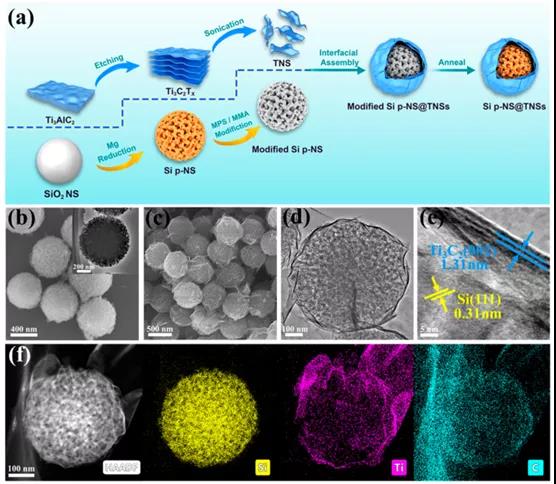
【Research Background】
Lithium-ion batteries are the main energy system for wearable electronic devices and electric / hybrid vehicles. Currently, the commercial graphene anodes are not sufficient to meet today‘s energy needs due to their low theoretical capacity (372 mAh g -1 ). As an ideal choice, silicon (Si) is one of the most promising negative electrode materials for the next generation of lithium batteries, due to its ultra-high theoretical capacity (4200 mAh g -1 ) and suitable lithium insertion potential (0.4 V vs. Li / Li + ) and the abundance of nature have aroused continuous attention from researchers. However, the negative electrode during cycling great volumetric change of silicon (up to 400%), itself lower conductivity (of 10 -3 S cm & lt -1 ) and lower lithium diffusion coefficient, often result in electrode powder and the more The high reaction irreversibility leads to the loss of battery capacity.
In order to overcome these shortcomings, MXene, as an emerging member of the 2D material family, has been widely concerned in the field of energy storage for its outstanding conductivity and synthetic compatibility since it was first reported in 2011. As the most representative Ti 3 C 2 T x MXene, it has a structure similar to graphene, but can transfer lithium ions faster and a higher charge and discharge rate, because its (0.07 eV) has a higher graphene Lower lithium diffusion barrier (0.3 eV). In addition, the abundant surface functional groups are easier to compound with other materials. In addition to being a conductive matrix, it can also provide a higher pseudocapacitance contribution, thanks to its rich redox reaction on the surface.
【Achievement Introduction】
Recently, Professor Haijiao Zhang of Shanghai University, Chi Zhang of Tongji University and Professor Jinhu Yang published the title in the internationally renowned academic journal ACS Nano : Ti 3 C 2 T x MXene Nanosheets as a Robust and Conductive Tight on Si Anodes Significantly Enhance Electrochemical Lithium Storage Performance research paper. The paper synthesized a core-shell structure and composite. Ti 3 C 2 T x nanosheets (TNS) as a conductive and stable material are tightly coated on the surface of Si porous nanospheres, which is a stable high capacity Negative electrode material for lithium ion batteries.
【Graphic introduction】

Figure 1. Schematic diagram of the synthesis process of the Si p-NS @ TNS composite electrode and the characterization of its micro-morphology: SEM, TEM, HRTEM, STEM and mapping.

Figure 2. XRD, Raman, BET and XPS patterns of Si p-NS @ TNS composite electrode and comparative samples.

Figure 3. Electrochemical performance test of Si p-NS @ TNS composite electrode: CV, EIS and cycling performance at current density.

Figure 4. Kinetic analysis of Si p-NS @ TNS composite electrode.

Figure 5. Finite element simulation of Si p-NS @ TNS composite electrode.
【Summary of this article】
In this paper, Ti 3 C 2 T x @Si composite electrode with core-shell structure was prepared by interface assembly and magnetocaloric reduction reaction . Ti 3 C 2 T x nanosheets enhance the interface contact with Si, thereby improving the electrical conductivity and structural stability, thereby avoiding powdering of the electrodes, and thus improving the performance of lithium storage. In addition, the mechanical simulation quantitatively revealed that the lithiated Si p-NS @ TNS composite electrode produced lower radial and hoop stresses, proving that the coating of TNS effectively enhanced the structural stability of the silicon anode.
Literature link:
https://dx.doi.org/10.1021/acsnano.0c01976
Source: MXene Frontier









